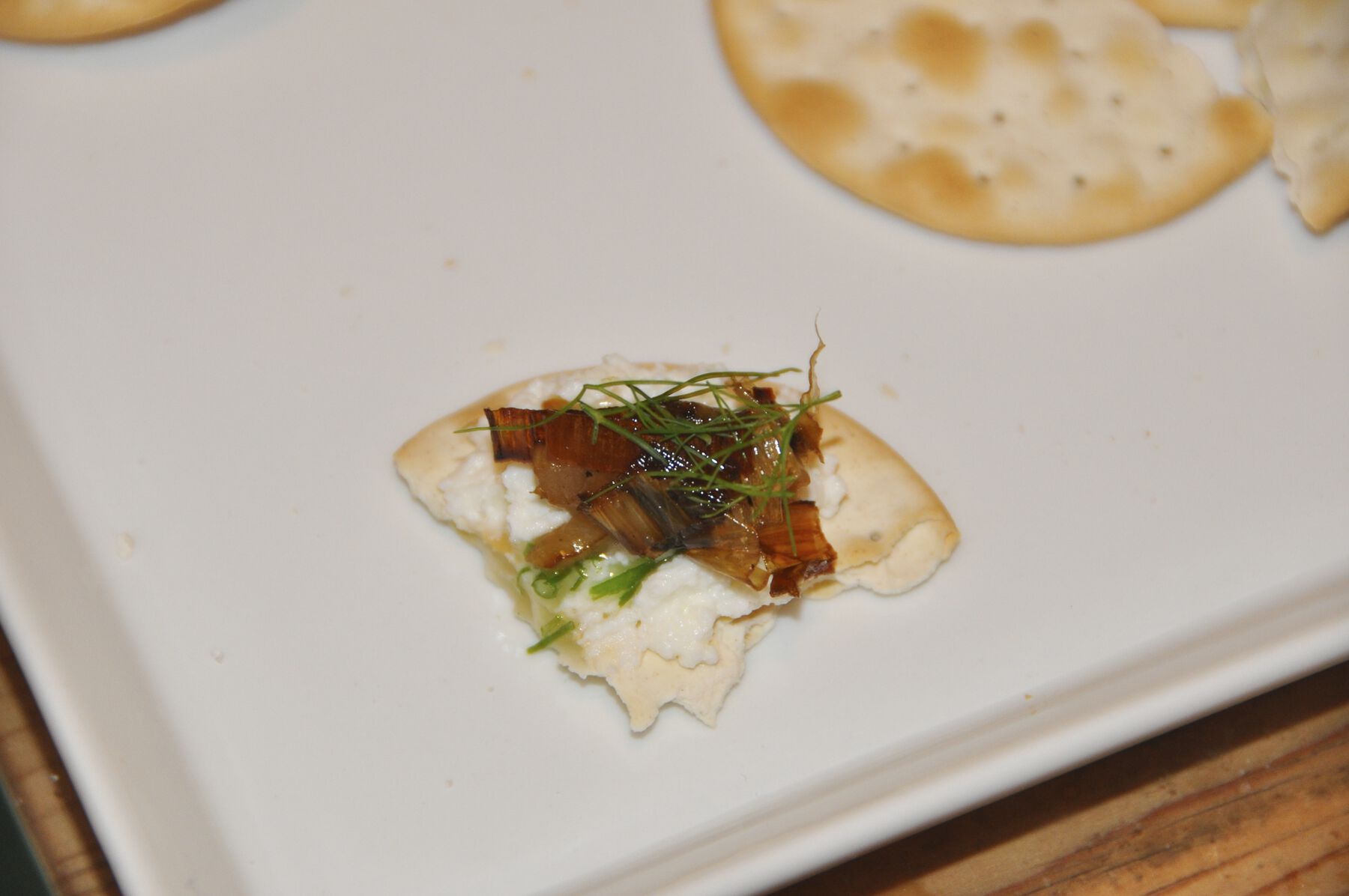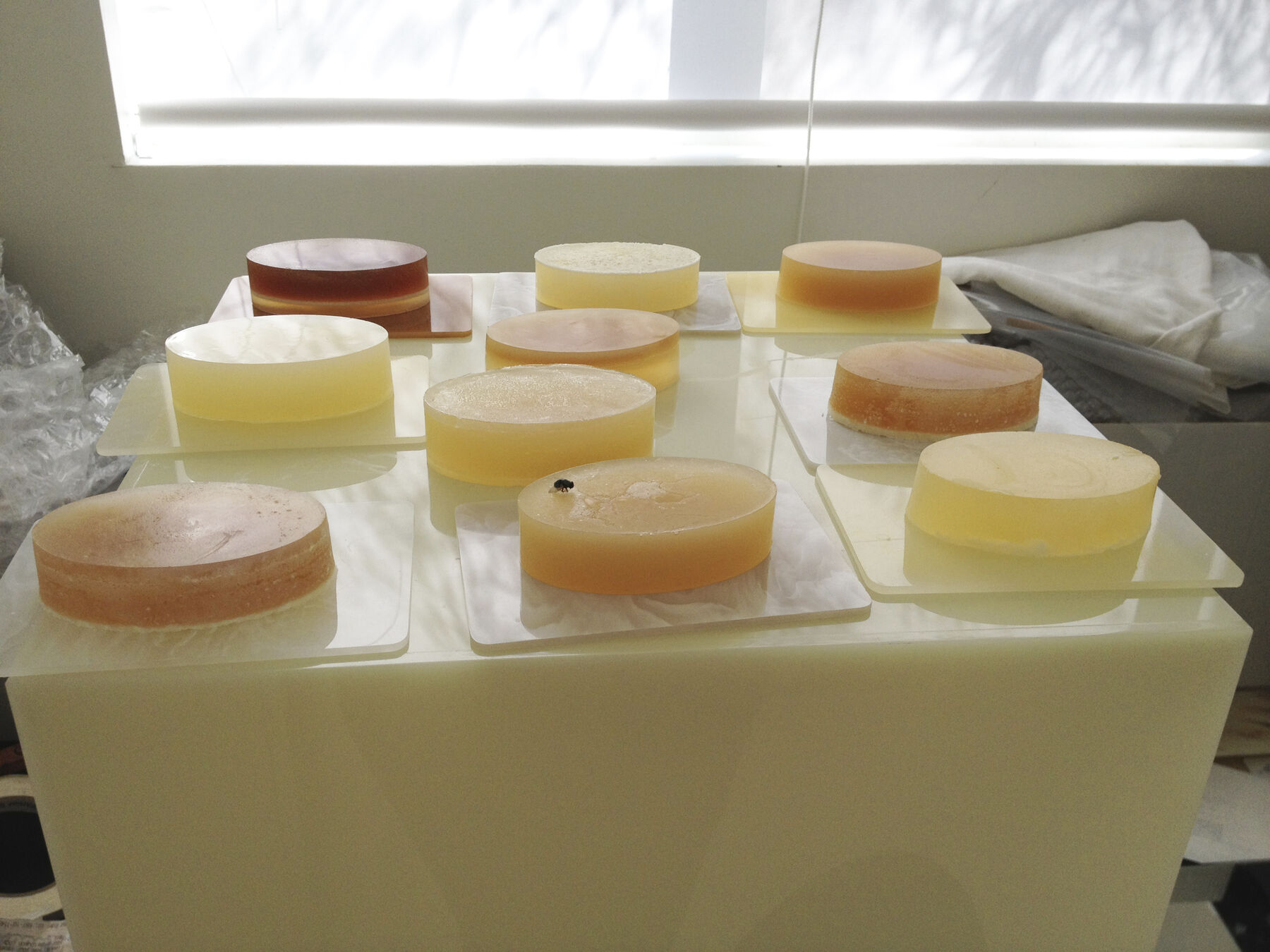23. Murmelte Instrumente: The Body, Like a Hand to an Instrument
- Kelly Kleinschrodt
We make music which is not Music, poems that are not Poetry, paintings that are not Painting, but music that may fit poetry, poetry that may fit paintings, paintings that may fit . . . something, something which gives us the chance to enjoy a happy, non-specialized fantasy.
—Festival of Misfits flyer, 19621
Prelude I: Elsewhere
Murmelte Instrumente is the title of a chapter within a larger ongoing project of mine: mother /cut. As a visual artist, mother, and arts educator, I find myself perpetually multitasking. I ask the same of my work.
My artistic practice is ultimately an experience and evocation of “moving between”—between bodies and objects, photography and sculpture, sculpture and performance, performance and video, video and photography. In mother /cut, this fluidity in approach seeps into the evolution of its central material: mother’s milk. I began the project symbolically alluding to the elusive nature of this vital liquid, but then I began producing the material myself, and incorporated actual breast milk as an integral living material and sculptural cornerstone of Murmelte Instrumente.
Similar to the epigrammatic title of Marcel Duchamp’s alter ego, Rrose Sélavy (pronouned Eros, c’est la vie), there are many transformations happening in Murmelte Instrumente. The German phrase translates to “muttering instruments.” Murmelte is literally an “utterance” or “mutter,” while Mutter is the German cognate for “mother,” and so we have either muttering instruments or Muttering instruments and mothering instruments. And, with my artworks toggling between multiple identities in this either/or/and paradigm (either photographs or sculptures and photo-sculptures), and with the referent toggling between “mutter” or Mutter, there is also momentary lapse. A reckoning with a lost moment of bodily exchange.
This text, too, is an evocation of moving between. The exchanges I describe herein—between bodies and objects—chart the shift in my practice toward music making, wherein materials are incited to enact a composition, to perform over time. This spurs a mode of artistic output reflective of the slipperiness of embodiment in life and art, the blurring and playful prodding of boundaries of artistic production / maternal production / music / consumption, wherein living matter occupies and inhabits space “like a hand to an instrument.”2
Prelude II: Another Elsewhere
Ah, the joy of suckling! She lovingly watched the fishlike motions of the toothless mouth and she imagined that with her milk there flowed into her little son her deepest thoughts, ideals, and dreams.
—Milan Kundera, Life Is Elsewhere, 19733
Outside the frame, my cousin, a nurse, pauses to pump milk before leaving for her shift. I am visiting her and happen to have my video camera. Natural light pours in from the window and her dark-green velvet couch miraculously registers as a black fabric studio backdrop.
In this moment, my work shifts from ambiguous depictions of the body (or of objects that look like bodies) toward an investigation of the ambiguity of the maternal body, wherein a breast can operate like a fallacious phallus and can perform with an outward fecundity by this vacuumous recipient, the breast pump. In the resulting video work, sonata (2010, fig. 23.1), the breast pump is an unapologetically transparent and melodious accompaniment to its instrumental soloist, the body-of-mother.4
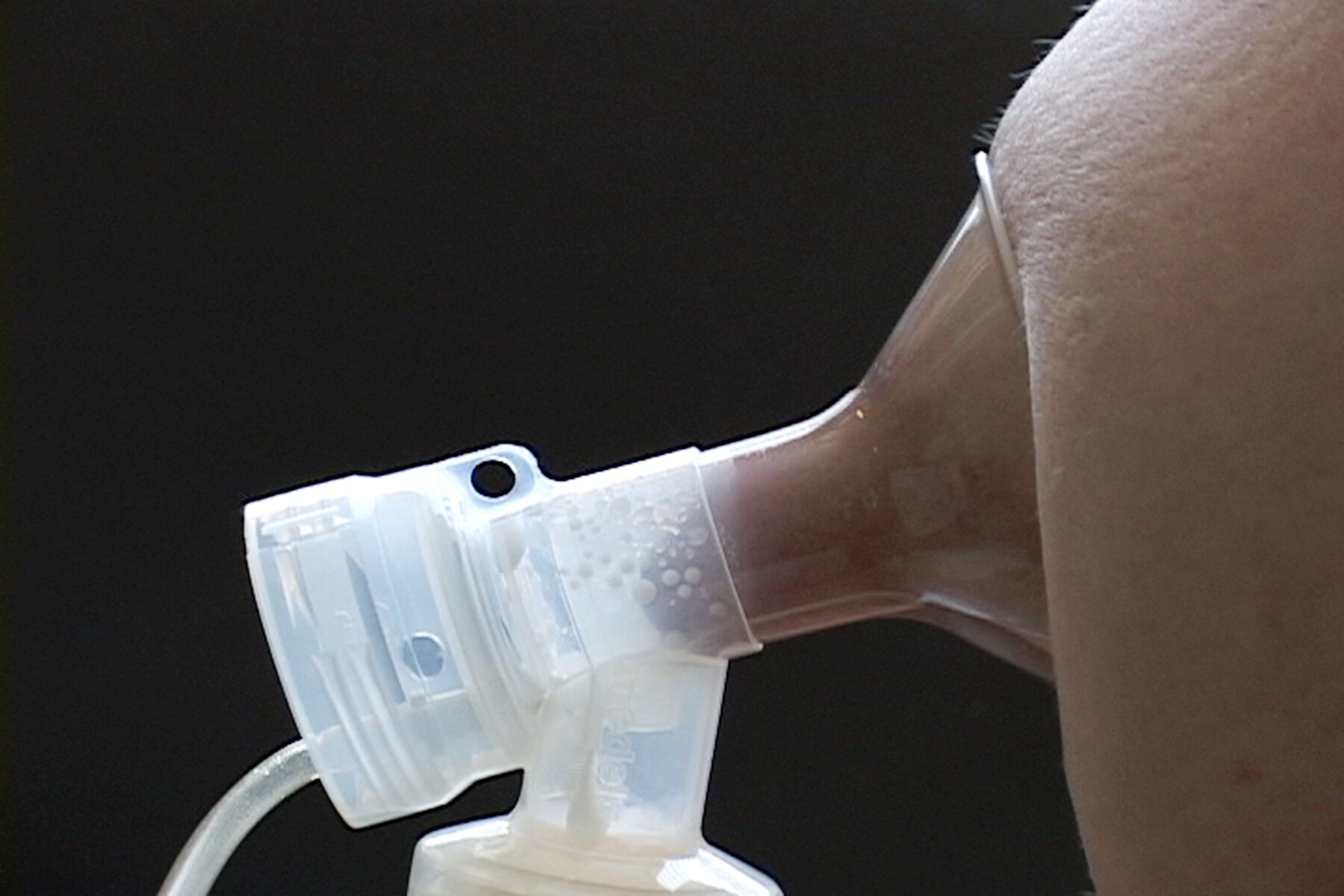 Figure 23.1
Figure 23.1First Movement: Drip
Shortly after I moved to Los Angeles in 2005, a confluence occurred in the form of a drip. Art historian Natilee Harren invited me to participate in an exhibition she was curating in response to George Brecht’s event score Drip Music (Drip Event) (1959–62). Harren’s Drip Event of 2007 was a one-night happening at a small art space in LA, and it featured a community of artists asked to interpret Brecht’s mimeographed text:
DRIP MUSIC (DRIP EVENT)
For single or multiple performance.
A source of dripping water and an empty vessel are arranged so that the water falls into the vessel.
Second version: Dripping.
G. Brecht
(1959–62)
I somewhat nervously accepted the provocation and platform. It was my first performance before a live audience, and so, naturally, I chose a gesture that would hide my face. For pillow / breath, I breathed face-down into a pillow until my saliva wet the outer contours of my face (fig. 23.2).5
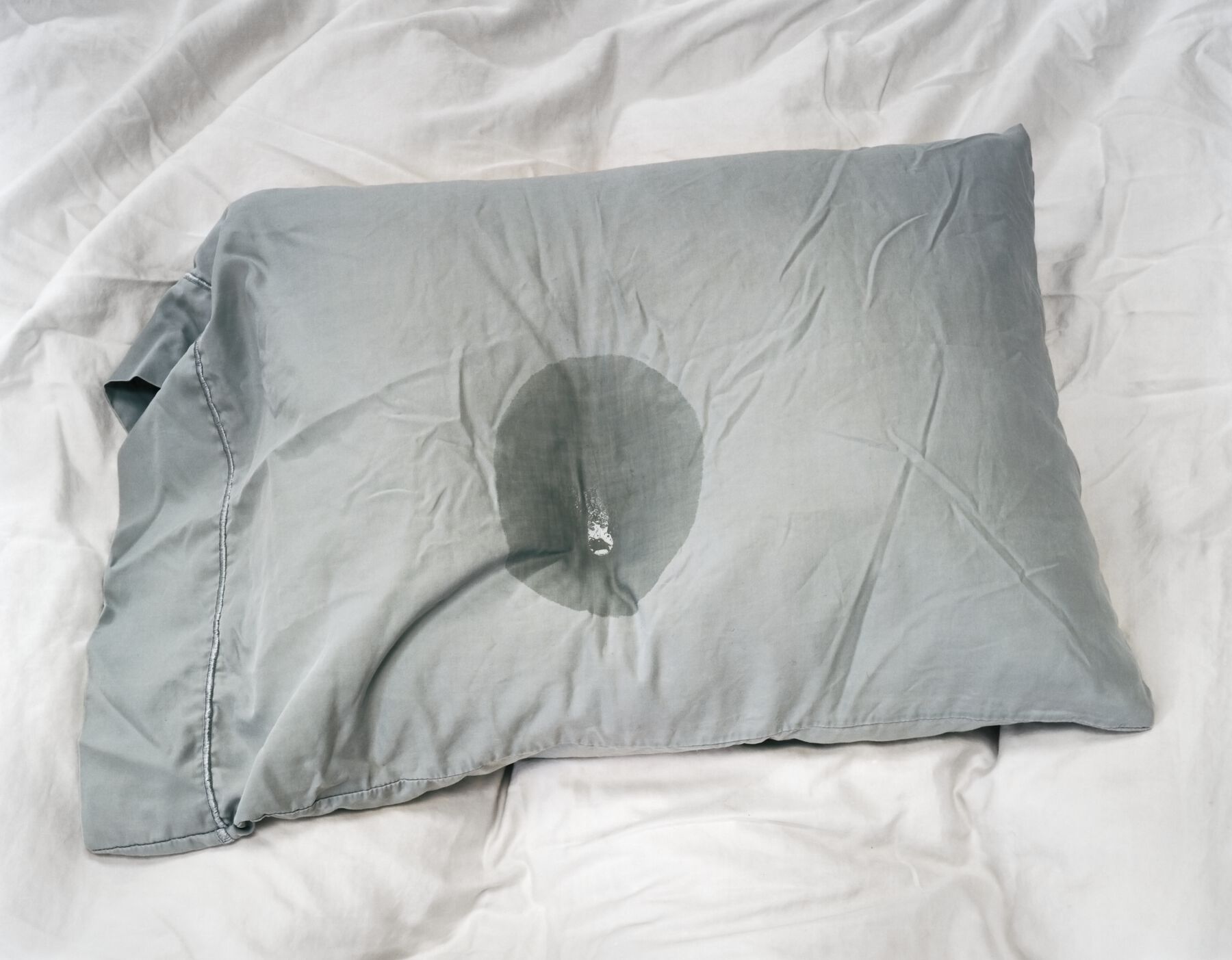 Figure 23.2
Figure 23.2The proposition to perform a rendition of Brecht’s score had me post-posthumously erecting a performance from a work previously considered “done.” From this event, iterations and multiples expanded outward, from resolved works into a state of always-in-process. My subsequent absorption of Fluxus ideology vis-à-vis Harren has had me experimenting with an “allographic . . . model of iterative production,” in which an artistic gesture is never fully done being realized.6 And another focus has emerged—toward feminine embodied experiences such as nurturing, creating, sterilizing, preparing food, and consuming while listening (aka “multitasking”). Banal activities like pumping breast milk, washing hands, preparing food, and listening are now centrally studied and elongated gestures in my practice. And, like Brecht’s score, my practice has evolved into a site in itself, a vessel perpetually in medias drip.
Second Movement: Proxy
Several years before I had my daughter and began to work with the material of my own body’s milk, I came across Wolfgang Laib’s Milk Stone (1978), an imperceptible collapsing of two iconic natural materials: marble and milk. I was completely enamored. Laib had delicately sanded a depression into the face of a thin, rectangular slab of Carrara marble, and then ritualistically poured milk in to fill the absence; at the surface level, the boundary between the reflective liquid and the opaque marble appears virtually seamless.7
I began making miniature variations of Laib’s Milk Stone, meddling nonchalantly with milk and, instead of hard marble, soap. I watched again and again as the lip I carved into soap bars dissolved upon contact with the milk, never to retain the illusion of synthesis. My efforts resulted in milk-soap puddles, which I documented in photographs made with a four-by-five camera. I then found modern substitutes for marble and milk, and made soymilkstyrofoam (2007, fig. 23.3). The soy milk was creamy in color and looked nothing like the stark-white Styrofoam base into which I poured it. I found these material and color differences amusing and visually appealing. It felt sentient, forthright, and somehow more alive.
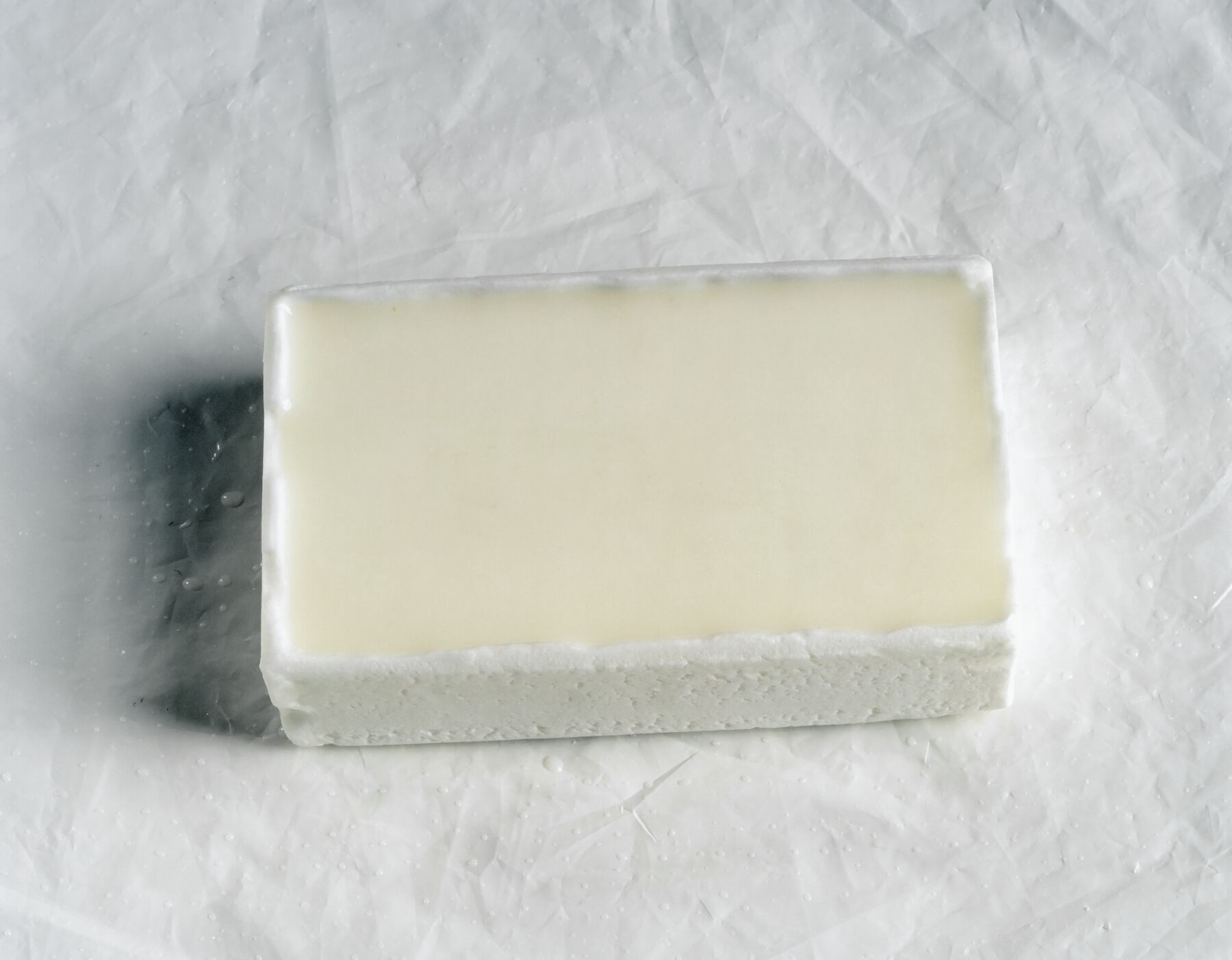 Figure 23.3
Figure 23.3Later, during my graduate studies at UCLA between 2009 and 2011, this tension between liquid and solid materials extended to the frame of the image. At this time, coinciding with the development of sonata, I began to make photographs of breast milk dripping down silky pink fabric.8 I decided to design and fabricate peculiar ivory-colored acrylic frames that would allude to colostrum, the rich breast milk produced in the days immediately after a baby’s birth (fig. 23.4). The frames were at once rigid and full of glossy depth, like a liquid surface. I also wanted a striking contrast between the surface of the frame and the surface of the print, so I decided not to glaze or protect the surfaces of the photographs. I would allow the naked final print to function as a skin, subject to time, UV light, dust, fingerprints. Just allowing. Each work would have a life span, slowly shifting over time—a proxy for the bodies I record with my camera.
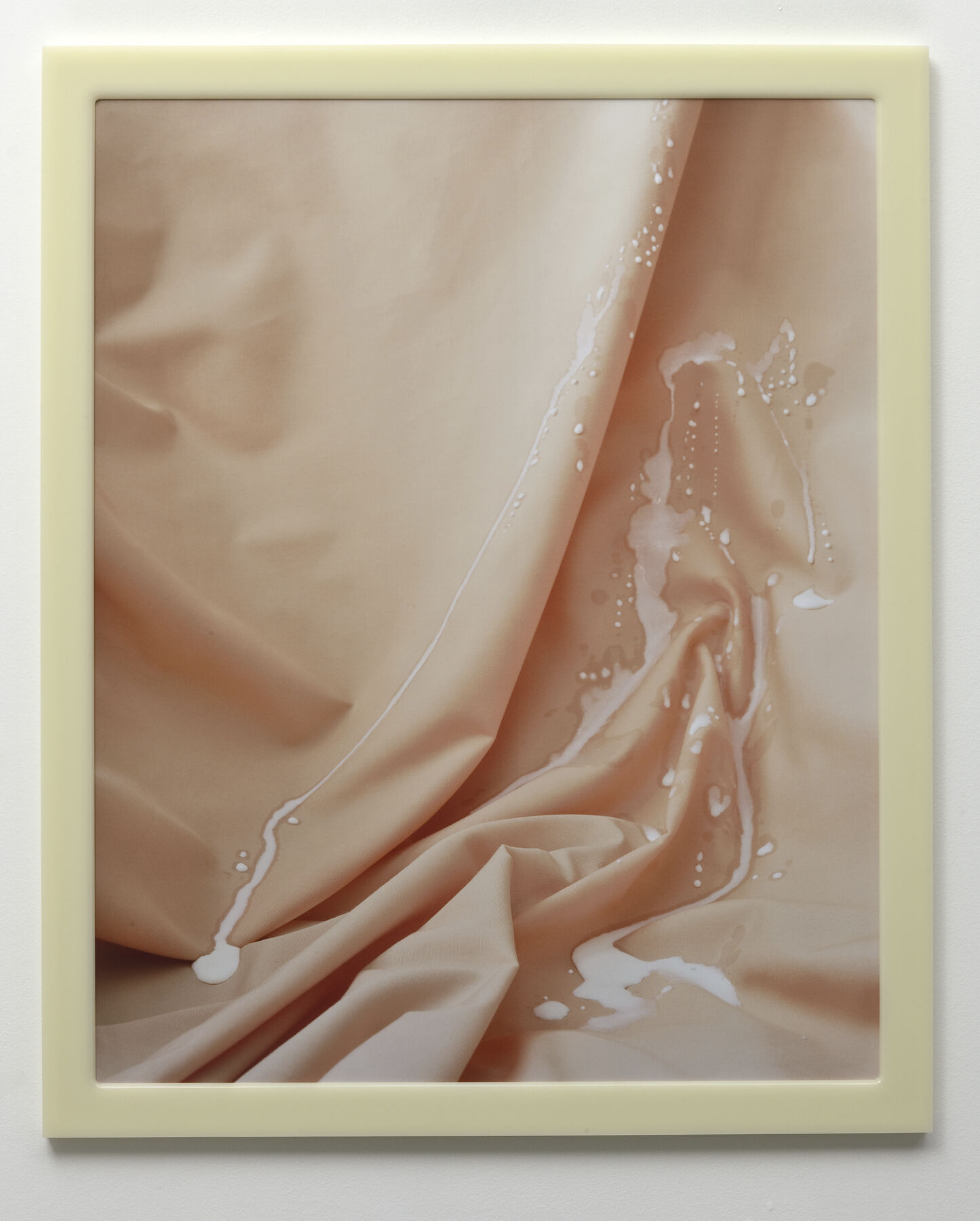 Figure 23.4
Figure 23.4In 2011, for my solo show distant already at Carter & Citizen in Los Angeles, I used the gallery space as an incubator for a thirty-day live performance, theme and variations (for solo violinist and breast pump), developed in collaboration with violinist Morgan Paros.9 During the run of the exhibition, Paros played daily at lunchtime to the amplified sounds of a breast pump that I had prerecorded (fig. 23.5). One important aspect of the work is that the written score provided to the violinist is suggestive, and so she becomes a coauthor/co-creator when playing the work. The violinist uses the theme melody as a foundation, but improvises variations in response to the breast pump’s distinctly changing rhythms. This collapse of artistic production—via surrogate author (the violinist) of maternal production (the artist’s) whetted via surrogate recipient (breast pump in place of infant)—had me wanting to push the idea of embodiment via proxy still further.
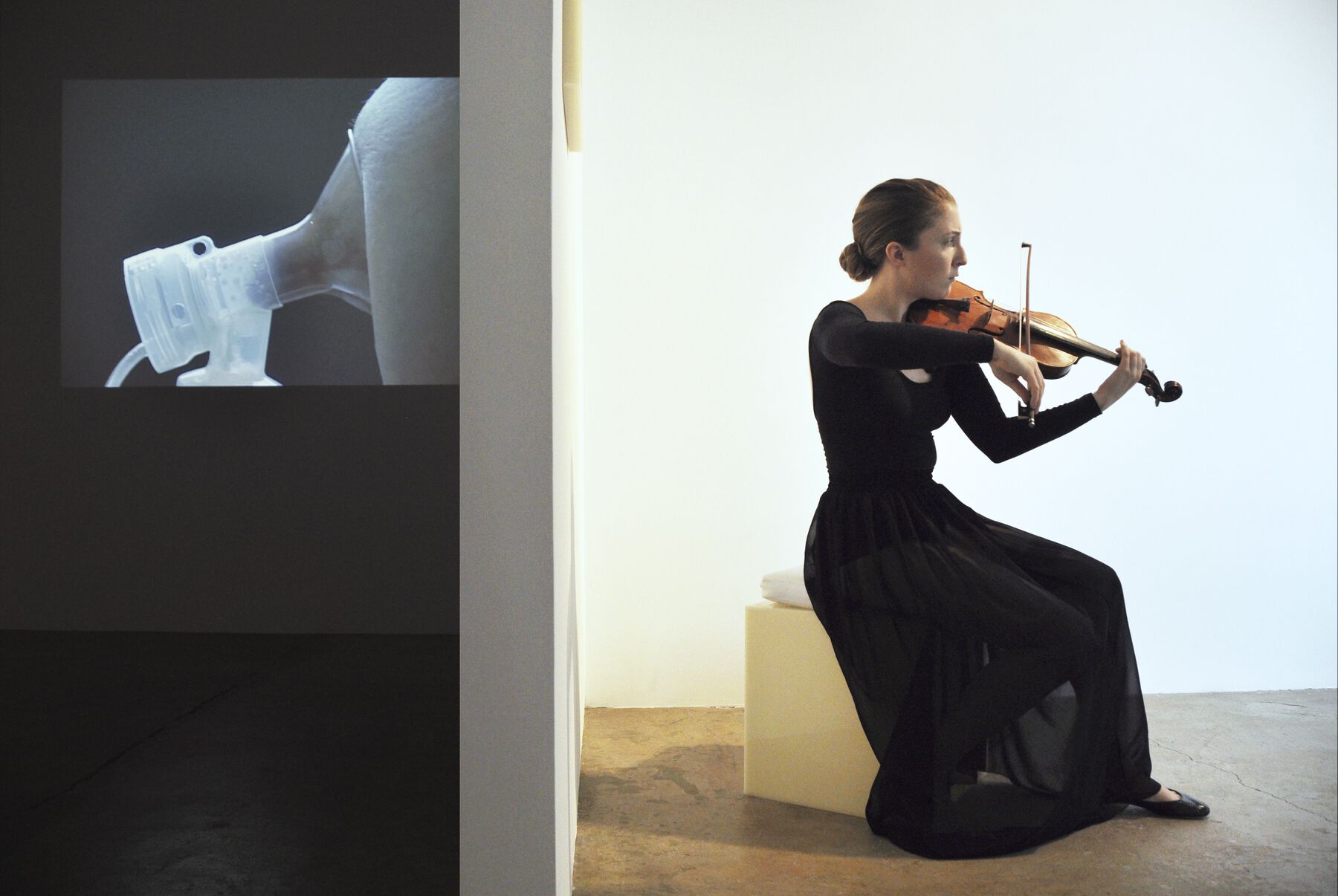 Figure 23.5
Figure 23.5For the closing of distant already, I decided to serve breast milk hors d’oeuvres from a close friend’s pumped and pasteurized breast milk, and I recruited artists Sarah Beadle and Emily Marchand to collaborate on the performance with me. Both women have an established practice of incorporating thematics of service, care, and embodiment into edible artworks. I provided the concept and framework of the muttermilch hors d’oeuvres, while Marchand brought an extensive knowledge of cheese making and Beadle concocted conceptual plant and pollen elements for the garnishes (fig. 23.6). The scanned receipts for the purchased ingredients that we combined with the breast milk to make the hors d’oeuvres remain as our pseudo-scores/recipes for future iterations.10 The hors d’oeuvres were casually passed and consumed adjacent to the video projection of an incessantly pumping breast.
Producer of milk.
Producer of meaning.
Producer of sound.
Producer of space.
Third Movement: Mutter
Two years after, in 2013, I became a pumping mother myself, with an ever-present, hissing metabolic metronome. The breast pump, which had formerly appeared in my artworks as an instrument for “music making,” became an intensely familiar companion—an instrument laden with associations of self-preservation and obsessive sterilization, a reflection and measure of my own performance as a mother. Luckily for myself and my infant, I was overperforming, and much milk was accumulating in my freezer.11 As some was set to expire, or was already too iffy to feed to my baby, I decided to repurpose my breast milk into soap sculptures.
I purchased a basic oval soap mold as well as an organic glycerin soap base and began making bars of breastmilksoap. The ingredients were minimal and motivated by personal associations: a clear glycerin soap base (which, having endured a terrible post-Cesarean infection, I associated with sterilization); frozen, then pasteurized breast milk (some of which was actually the first milk I produced at the hospital); castor oil (I self-induced using it); and honey (my only caloric intake during labor). One morning I sat at the kitchen table and held my young infant while my assistant, Taryn Haydostian, became an extension of my hands. We kept loose notes and labeled each bar numerically. We stirred the pot of ingredients at low heat, increasing the complexity of the base. The proportions of the ingredients in each bar of breast-milk soap were improvised. They involved an impressive variety of surfaces and textures (fig. 23.7). My kitchen thermometer happened to be broken. We were eyeballing, and there is no way to exactly replicate what happened that day. We got incredibly lucky.
My gallerist, Whitney Carter, caught wind of these works and provided a platform for them in a group show of small sculptures, titled heroes, at Carter & Citizen in 2013. It was during this exhibition that I realized the complexity of caring for these objects. The bars of soap with honey and castor oil were slightly sticky and attracted dust. In warm conditions, beads of sweat might form on their surfaces, uniformly distributed; if a sweating bar was handled, a fingerprint might later appear once the air temperature cooled. Several bars without honey and castor oil, made only of breast milk and glycerin, developed a delicate white crust and did not mark as noticeably. I would regularly stop by the gallery to attend to the soap works with canned air or a dry fingertip. But attending to them daily was not always feasible, and so Whitney became their surrogate caretaker. And so began the inevitable relinquishment of control.
With more exhibitions on the horizon, I started to incorporate the bars of breastmilksoap as components of, or companions for, other works. One such sculpture, mothersink (2014, fig. 23.8), features a satirical merging of a surgeon’s scrub sink and a domestic sink; on an acrylic soap dish platform that extends from the sink’s backsplash rests a breastmilksoap bar. In another work, the diptych bodyofmother / breastmilksoap (for E.) (2014, fig. 23.9a, fig. 23.9b), the soap is juxtaposed with a photo-sculpture; it sits on an independent platform directly screwed into the drywall, just below and to the right of the framed photograph, which pictures a body of water tinted to resemble a body of milk. This is an imagined view for my daughter, a view from the body of mother—contained, but separate.
 Figure 23.8
Figure 23.8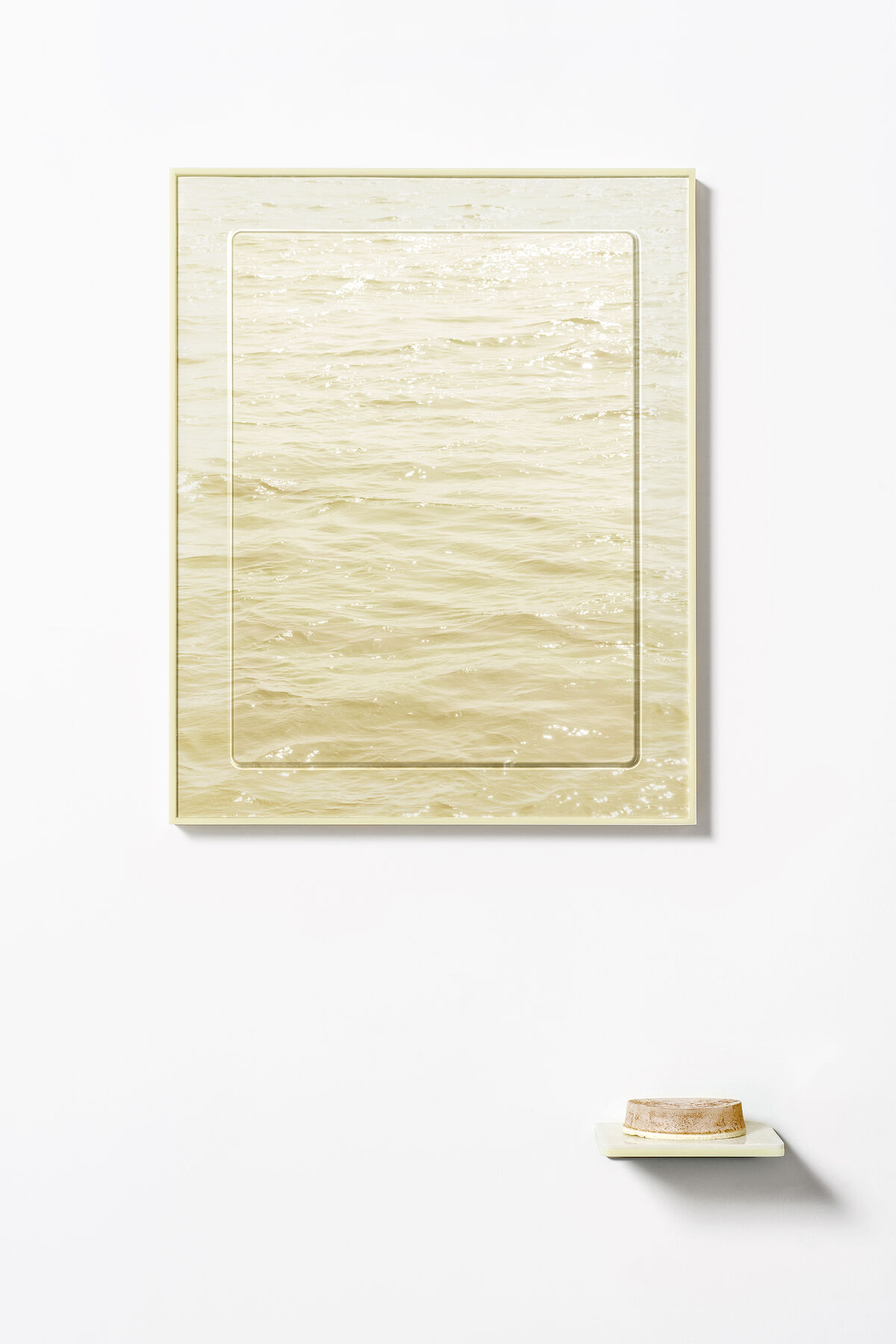 Figure 23.9a
Figure 23.9a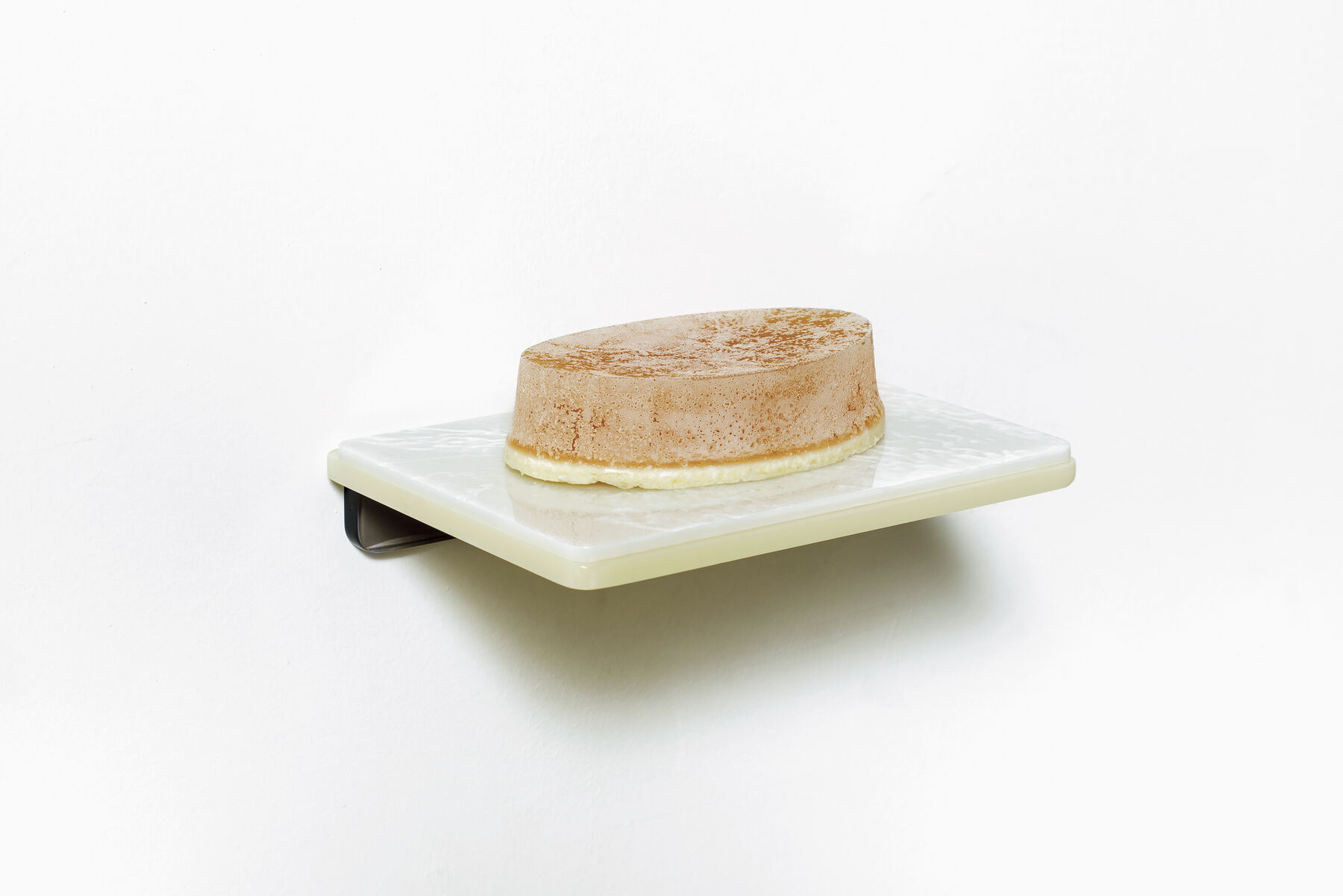 Figure 23.9b
Figure 23.9bPostlude I: Elsewhere (Control Lapse)
Murmelte Instrumente started traveling. The breastmilksoap works were included in exhibitions and art fairs in the United States and abroad. To an exhibition in Chicago in 2014, I was able to hand carry the soap works, wrapping the bars in glassine before placing them in individual plastic soap containers (purchased from the Dollar Tree). Soon after, Josh Lilley gallery in London requested a selection of breastmilksoap for the group show Control Lapse (2014). Lilley also hand carried the bars in makeshift packaging, and they miraculously arrived unscathed. But, interestingly, in the exhibition documentation I noticed that breastmilksoap (variation V) (2013, fig. 23.10) had acquired visible fingerprints from being handled. The marks (most likely my own, but quite plausibly from airport security or someone at the gallery) had become acutely visible because of temperature and humidity. At first I was uncomfortable with the sharpness of the surface marks, which rupture the pristine, gemlike quality of the semitranslucent objects. But these marks provided an alternate latency, one that worked within me, and circled me back toward the philosophical origins of my work as a photographer. It became somehow necessary that I embrace the fingerprints as punctum—as poignant but unintended occurrences within the works, “a kind of subtle beyond . . .”12 And although the soap works were not photographs, I came to understand them as encapsulations of moments, and the fingerprints as indexical evocations of being held.
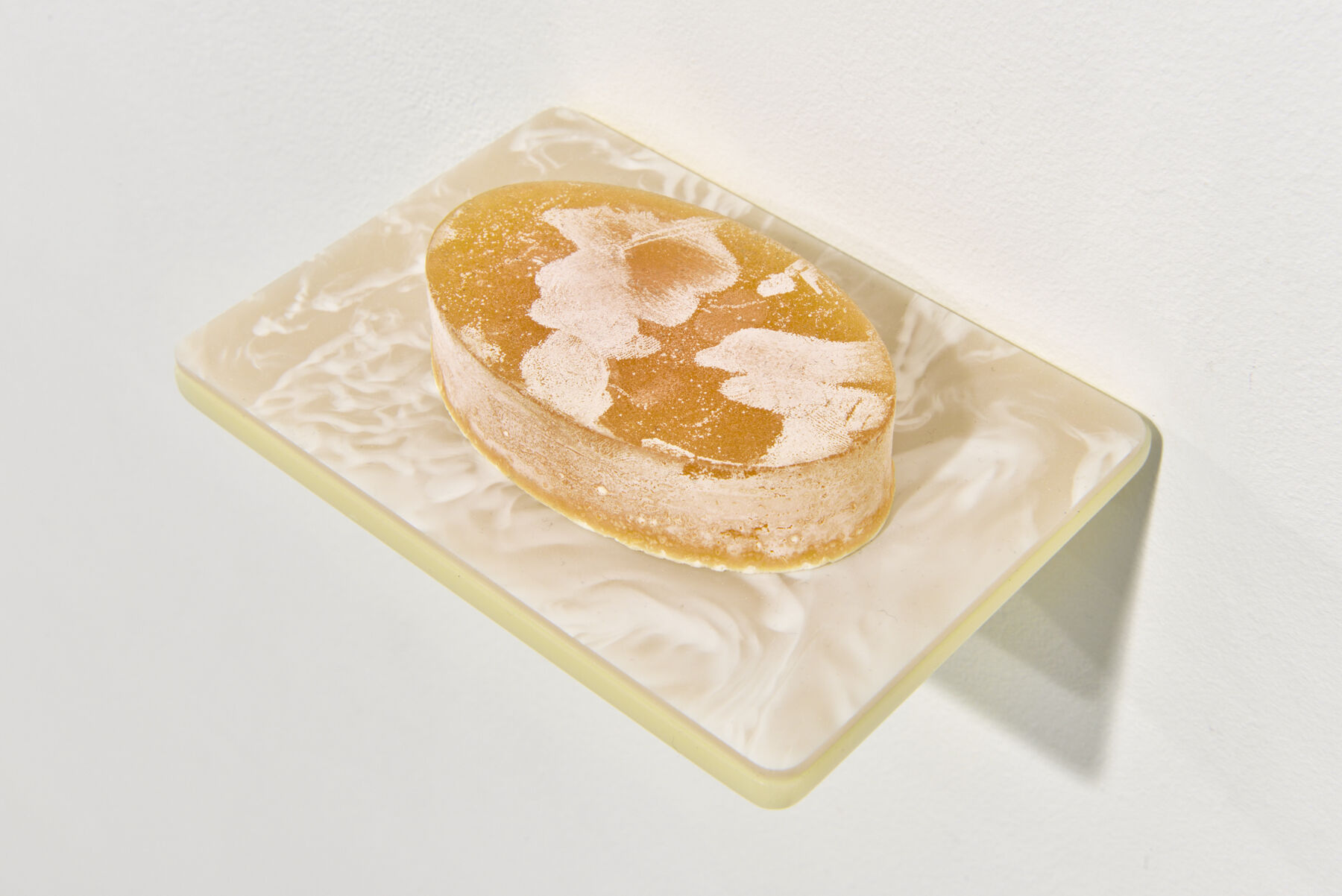 Figure 23.10
Figure 23.10When Lilley sold three bars of soap to a New York–based collector, I was asked by the gallery to provide conservation advice. I had not yet researched what “best practices” would mean for such delicate objects. I reached out to the Getty Research Institute (GRI) and Getty Conservation Institute (GCI) for a consultation, having heard of Fluxus works containing canned biological matter in the GRI Special Collections.13 Conservators Mary Sackett and Rachel Rivenc graciously provided conservation recommendations as best they could without having seen the physical objects. I passed this information on to the gallery in a highly detailed document meant for both the gallery and the collector regarding long-term storage measures and guidelines for interacting with the objects. This document not only covers best conservation practices, but also includes my own guidelines for permissible handling of the works: “latex gloves or simply clean, dry hands.” I further indicate that if the soap collects dust to an “unsavory and distracting” extent, its surface can then be “re-smoothed and dusted with a wet finger.” This advice is, of course, in keeping with my conclusion that the handling of the work and any resulting marks are a conceptual component of the work; once relinquished by me, the soap bar is to be handled at the discretion of the caretaker.
I often wonder what happens on the receiving end of my objects. For breastmilksoap, how have they held up in the colder climates of London, New York, and Brussels? What was each collector’s compulsion to own a sculpture with an uncertain expiration date or life span? What has been the recent history of the objects—how have they been displayed or stored?
I recently attempted to contact the various collectors of breastmilksoap. To date, I have received one ebullient but brief response from the collector of mothersink (2014): “The work is in storage but that is only a physical aspect. It is in my heart and mind. Therefore close to me.” Although this response is short, and reveals that the stored work’s precise condition may be unknown to the collector, it is the memory of the initial encounter—or, rather, the re-remembering of the initial encounter—that appears to be the most revered “site” of the work. So perhaps for this collector, the work has less to do with the object’s state in this particular moment, and more with how it occupies and transgresses time.
I relinquished the soap works in January 2014, only a few months after they were made. Having released them to circulate in contexts beyond my control, I find myself embracing this uncertainty as a central quality of the work. It tempers and healthfully reframes my own attachment to these highly charged objects, made during an incredibly personal and vulnerable moment. In making these works, in choosing studio time over time spent with my child, I had to pump milk. Most of the milk went to my child, but the remaining ounces went elsewhere.
The markings on the surfaces of breastmilksoap are literally indexical of exchanges, and specifically of being held. Implicitly, each mark is an index of a lost moment of bodily exchange—between mother and child, mother and breast pump, hand and soap, artist and preparator, artist and collector. I find that it is precisely this condition of “moving between” that makes works with biological matter conceptually rigorous, and utterly human. Each bar of soap will ever so slowly shift, absorb, acclimate, and inhabit space. This is an object that encapsulates a performance and can also perform. It is neither a thing nor a body; it’s like a hand to an instrument.
Notes
From a flyer for the Festival of Misfits, Gallery One and ICA, London (1962). Natilee Harren writes: “In this statement we see, crucially, that within Fluxus intermedia the language of individual mediums was roundly disrupted but not abandoned. Rather, new practices are seen to emerge from artists’ engagement with multiple mediums at once, mediums set into new relations with one another or that are coarticulated while remaining individually legible” (). ↩︎
“Our body is not in space like things; it inhabits or haunts space. It applies itself to space like a hand to an instrument, and this is why, when we want to move about, we do not move the body as we move an object. We transport it without instruments as if by a kind of magic, since it is ours and because through it we have access directly to space. For us the body is much more than an instrument or a means; it is our expression in the world, the visible form of our intentions” (). ↩︎
, 9. Before this Kundera quotation was co-opted here, it was a viral Instagram post by Alyssa Milano after ten ounces of her breast milk were confiscated at Heathrow Airport in 2014. Coincidentally, Ignorance (2002), a novel by Milan Kundera, is currently on my bedside table. Michi Jigarjian and Qiana Mestrich, How We Do Both: Art and Motherhood (New York: Secretary Press, 2015), is also currently on my bedside table. ↩︎
Body-of-mother is a term I use in my work to refer to the poetic terrain of the mother’s body. It is a horizonless gulf, an endless supply of ______, the ultimate site of projection. sonata has primarily been exhibited as a video installation. sonata (for breast pump), variation I (2011) has an audio component; sonata (for breast pump), variation II (2011) does not. ↩︎
I still have this pillowcase and pillow. The pillowcase has been washed between iterations; the pillow has not. ↩︎
“Fluxus developed an allographic as opposed to autographic model of iterative production, in which artworks—both performances and objects—were created or realized over and over again to differing results. In Fluxus performance practice, works such as Brecht’s Drip Music (Drip Event) (1959–62) gradually morphed in appearance from concert to concert, producing also sculptural versions; and by design, Fluxus’s editioned multiples, whose production was overseen by [George] Maciunas, never promised to contain the same items from one ‘copy’ to the next. In work after Fluxus work, we see the marriage of a general set of processes or qualities materialize in unique, specific situations. Furthermore, the manifold outcomes of an individual Fluxus score, instruction, diagram, or idea would be seen as inherently relatable to one another” (). ↩︎
For a re-creation of the work see https://vimeo.com/68268886. ↩︎
The images of this series, falling (2011), were made in response to an anecdote my cousin shared as she was pumping milk while I shot video for sonata. She recounted her first day back at work, as a nurse, after maternity leave. To her dismay, an attending physician pulled her aside to let her know that breast milk was leaking through her scrubs. The images of falling are also direct quotations of James Welling’s Drapes (1981), photographs of phyllo dough flakes falling down luscious folds of fabric. Welling was my graduate school mentor at UCLA, and his conceptual abstractions have provided a foil for my theatrics of maternity. ↩︎
Morgan Paros was one of three violinists who answered my Craigslist ad looking for a violinist. She is currently my child’s legal guardian (my posthumous proxy). ↩︎
We developed three hors d’oeuvres, each with a human and animal milk base (as human milk isn’t fatty enough to make cheese). One paired, for example, fennel pollen with poached pear and breast-milk chèvre. The hors d’oeuvres were passed around by artist Tiffany Smith, who reported that 85 percent of attendees sampled them. ↩︎
As of September 2019, I still have an entire drawer of frozen breast milk from 2013–14. ↩︎
“The punctum, then, is a kind of subtle beyond . . .” (, 59). Barthes’s philosophical approach reads images by articulating the punctum as the small, often overlooked “detail” within the photograph that ultimately has “a power of expansion” (45). Importantly: “Nothing surprising then, if sometimes, despite its clarity, the punctum should be revealed only after the fact, when the photograph is no longer in front of me and I think back on it” (53). ↩︎
For example, Harren has mentioned Piero Manzoni’s Artist’s Shit (1961), an edition of canned excrement. Harren and I have also discussed Benjamin Patterson’s Hooked (1980), a tackle box with a plethora of rotting matter—most odiferously, a disintegrating can of sardines in tomato sauce. See Harren’s contribution to this volume. ↩︎
Bibliography
- Barthes 1981
- Barthes, Roland. 1981. Camera Lucida. Translated by Richard Howard. New York: Hill and Wang.
- Harren 2015
- Harren, Natilee. 2015. “The Crux of Fluxus: Intermedia, Rear-guard.” Walker Art Center, http://walkerart.org/collections/publications/art-expanded/crux-of-fluxus.
- Kundera 1974
- Kundera, Milan. 1974. Life Is Elsewhere. Translated by Peter Kussi. New York: Alfred A. Knopf.
- Merleau-Ponty 2007
- Merleau-Ponty, Maurice. 2007. “An Unpublished Text by Maurice Merleau-Ponty: A Prospectus of His Work,” translated by Arleen B. Dalery. In The Merleau-Ponty Reader, edited by Ted Toadvine and Leonard Lawler, 285. Evanston, IL: Northwestern University Press.
